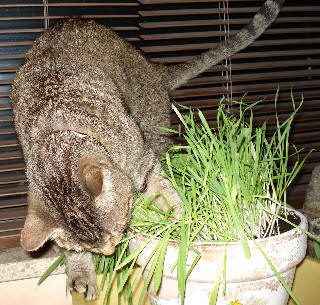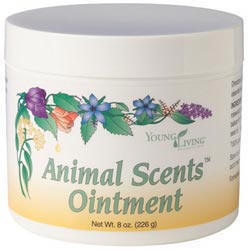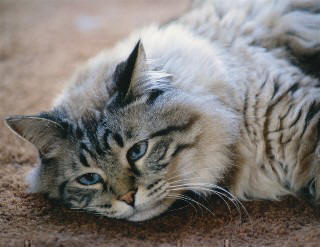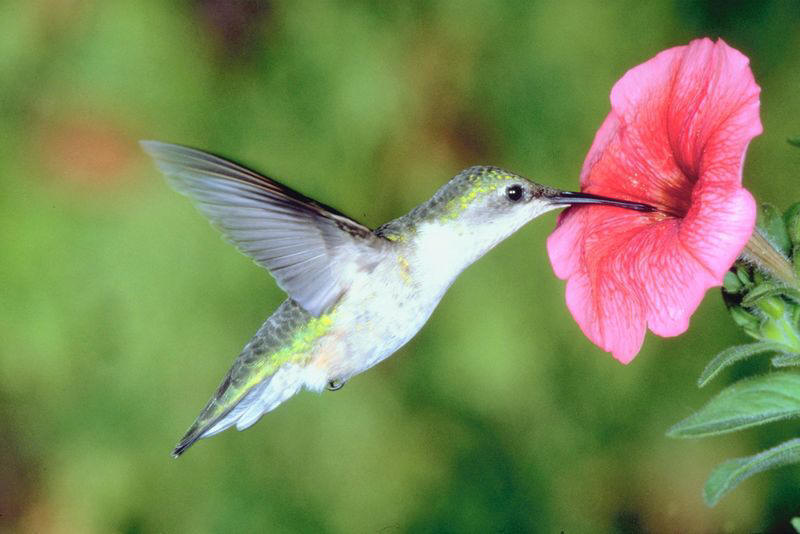Safe Essential Oil Usage With
Animals
|
Optimum Choices offers only therapeutic Grade A essential oils.
For more information or to purchase these oils
online, contact our essential oils expert and business partner, J.R. Roessl:
-
If you have a specific essential oil question, e-mail
her at
J.R. Roessl.
-
For
personal essential oils questions and to order, call
917-861-5247, and tell her Optimum Choices sent you.
|
The similarity to humans made horses and dogs ideal
test subjects for essential oil research in the early 1900ís. There are more
case histories and research done on horses and dogs than any other animal.
Because of the resurgence in aromatherapy today, our other domestic animals such
as cats, birds, hamsters, gerbils, etc. are now being treated with essential
oils and our volume of case histories is accumulating. One case reported by a
veterinarian was a cat found listless, unable to walk or crawl, after the owner
applied just one drop of undiluted peppermint oil to the catís stomach. The
vetís diagnosis was a mysterious case of poisoning and administered fluids and
prescribed a two day stay in the clinic. Fortunately, the cat finally was able
to go home. Another case concerned a cat that was distressed, disoriented and
hypothermic after it was bathed in citronella oil. The cat was washed to remove
any essential oils, given I.V. fluids but went into shock, its temperature rose,
and it exhibited abnormal movements. Unfortunately, the cat had to be
euthanized. Because of such extreme cases, some aromatherapists advocate never
using any essential oils on cats. On the other end of the spectrum,
therapeutic-grade essential oils have been credited with saving a catís life
from blood clots and cardiomyopathy (a heart disease).
Kristen Leigh Bell did her masters thesis on
aromatherapy and animals and wrote a book entitled
Holistic Aromatherapy for Animals (2002,
Findhorn Press). Kristenís book used more
up-to-date case studies and practical research over the last ten years.
Please do not contact Kristen as she no longer works in aromatherapy or
with animals. Like
Kristen, I believe in a moderate practice of using aromatherapy with animals.
The following is a compilation of my research. Youíll have to form your own
opinion as to what is appropriate for you and your companion animals.
|
|
 When
wild dogs, wolves, cats and horses are sick they seek out certain plants to
eat in order to get well. As we domesticated these animals they lost this
instinct and their access to wild plants. Plants combine minerals from the soil,
water and energy (in the form of sunlight) to produce certain chemical compounds
(a process called photosynthesis). These essential chemical compounds nourish
the plant, protect the plant, heal broken parts, counteract infections and
fungus, attract insects for reproduction and allow the plant to adapt to harsh
environmental conditions. All these healing properties are encoded in the
plantís DNA which is embedded in the plantís resin or essential oils. To obtain
these same healing benefits animals will seek out certain plants, eat them and
digest the plant material for the healing chemical compounds. Plant metabolism
is a precursor to human existence. Humans have learned to ingest the same plants
(or herbs) as animals to metabolize the same healing substances. This process is
called the biosynthetic blueprint. When
wild dogs, wolves, cats and horses are sick they seek out certain plants to
eat in order to get well. As we domesticated these animals they lost this
instinct and their access to wild plants. Plants combine minerals from the soil,
water and energy (in the form of sunlight) to produce certain chemical compounds
(a process called photosynthesis). These essential chemical compounds nourish
the plant, protect the plant, heal broken parts, counteract infections and
fungus, attract insects for reproduction and allow the plant to adapt to harsh
environmental conditions. All these healing properties are encoded in the
plantís DNA which is embedded in the plantís resin or essential oils. To obtain
these same healing benefits animals will seek out certain plants, eat them and
digest the plant material for the healing chemical compounds. Plant metabolism
is a precursor to human existence. Humans have learned to ingest the same plants
(or herbs) as animals to metabolize the same healing substances. This process is
called the biosynthetic blueprint.
Aromatherapy primarily works on the physical level of animals since animals
donít have many of the emotional connections to scents as humans do. For
example, animals donít connect romance with rose oil and holidays with orange
and cinnamon oil the way humans do. It is important to introduce animals to
essential oils with a positive experience. Do not introduce animals to essential
oils when they are fearful from people, loud noises such as storms or in pain or
shock. It is always best to let the animal smell the oil first before applying.
Then watch for signs of acceptance such as wanting to lick the oil, rubbing
against you or wide-eye and bushy tailed. Signs the animal dislikes the oil are
turning their head away, panting, drooling, pacing, whining and sneezing or
snorting. Never put essential oils on an animalís nose or snout. This takes away
their freedom of choice and is intrusive therapy. Most companion animals have
considerably less body mass than an adult human. The rule-of-thumb I use for
smaller animals is the same as for childrenóif the dosage for essential oils is
not stated start with at least a 10% dilution of the adult human dose. For
example, one drop of essential oil to 9 drops of carrier oil (e.g., almond,
hazelnut, jojoba, olive oil).
 Melaleuca alternifolia (Tea Tree oil) has been widely used for years for both
humans and pets. But there have been many reports of animals that developed
uncoordination, weakness, tremors, behavioral disorders and even depression
after using melaleuca oil. This was probably due to using undiluted oil or poor
quality oil. The Australian standard states that pure melaleuca oil must have
cineole greater than 15% and terpinen-4-ol greater than 30%. I suspect the bad
case histories of melaleuca oil resulted from using oil from a manufacturer that
doesnít test every batch of their oil. Melaleuca oils with chemical compositions
outside the Australian standard have been known to be caustic when applied full
strength. My suggestion is to always use a therapeutic grade (Grade A) melaleuca
oil from a manufacturer that tests every batch of oil and always dilute the
melaleuca oil before using on animals. Melaleuca alternifolia (Tea Tree oil) has been widely used for years for both
humans and pets. But there have been many reports of animals that developed
uncoordination, weakness, tremors, behavioral disorders and even depression
after using melaleuca oil. This was probably due to using undiluted oil or poor
quality oil. The Australian standard states that pure melaleuca oil must have
cineole greater than 15% and terpinen-4-ol greater than 30%. I suspect the bad
case histories of melaleuca oil resulted from using oil from a manufacturer that
doesnít test every batch of their oil. Melaleuca oils with chemical compositions
outside the Australian standard have been known to be caustic when applied full
strength. My suggestion is to always use a therapeutic grade (Grade A) melaleuca
oil from a manufacturer that tests every batch of oil and always dilute the
melaleuca oil before using on animals.
 Dogs have a large nasal cavity and their
sense of smell is 50-100 times stronger
than humans. Always avoid any oils high in phenols and ketones (see chart
above). Avoid stimulating oils of peppermint, rosemary, niaouli, melaleuca (Tea
Tree), spearmint, ravensara and eucalyptus unless in highly diluted form. It is
also recommended to avoid rosemary on dogs that are prone to seizures or with
epilepsy. It is not recommended to use essential oils on medium to large breed
puppies younger than eight weeks. For small or toy breed puppies wait at least
until they are older than ten weeks. When in doubt use the gentler hydrosols
(by-products of essential oil distillation) on puppies instead of essential
oils. Dogs have a large nasal cavity and their
sense of smell is 50-100 times stronger
than humans. Always avoid any oils high in phenols and ketones (see chart
above). Avoid stimulating oils of peppermint, rosemary, niaouli, melaleuca (Tea
Tree), spearmint, ravensara and eucalyptus unless in highly diluted form. It is
also recommended to avoid rosemary on dogs that are prone to seizures or with
epilepsy. It is not recommended to use essential oils on medium to large breed
puppies younger than eight weeks. For small or toy breed puppies wait at least
until they are older than ten weeks. When in doubt use the gentler hydrosols
(by-products of essential oil distillation) on puppies instead of essential
oils.
Oil blends seem to work best on canines. Essential oils have a very profound
effect on shelter, rescue and adopted dogs. They help the dog bond with the
owner after
 such a traumatic experience.
Veterinarians have reported success
using frankincense on dogs with gum disease. Like humans, lemongrass is good for cruciate ligaments and joint injuries. Lavender and a blend of valerian,
vetiver, petitgrain, sweet marjoram and sweet orange are good for calming and
relieving the stress for show dogs. For arthritis use the anti-inflammatory
blend peppermint, cypress, juniper berry and lavender. Dogs and horses, being
similar to humans, tolerate oils better than other animals. Cats and birds are a
totally different story. such a traumatic experience.
Veterinarians have reported success
using frankincense on dogs with gum disease. Like humans, lemongrass is good for cruciate ligaments and joint injuries. Lavender and a blend of valerian,
vetiver, petitgrain, sweet marjoram and sweet orange are good for calming and
relieving the stress for show dogs. For arthritis use the anti-inflammatory
blend peppermint, cypress, juniper berry and lavender. Dogs and horses, being
similar to humans, tolerate oils better than other animals. Cats and birds are a
totally different story.
Catís livers do not have the necessary enzymes to break down and excrete certain
chemical compounds in essential oils. The chemical compounds, therefore,
accumulate in a catís body and are sometimes toxic to the point of death. Cats
are very sensitive to beta-carotene, morphine, certain sulfanomides, salicylic
acid (Aspirin), acetaminophen (Tylenol), allyl propyl disulfide (onions) and
compounds with the bezene ring (benzyl alcohol preservative). Wintergreen and
birch oils contain methyl salicylate the same chemical compound in aspirin. It
is best to avoid any oil containing phenols: oregano, thyme, cinnamon (cassia),
clove, savory, birch, and melaleuca (Tea Tree oil) or ketones: sage. A third
group to avoid are the monoterpene hydrocarbons pinene and limonene most
commonly found in the citrus and pine oils: lemon, orange, tangerine, mandarin,
grapefruit, lime, bergamot, pine, spruce, and any fir oil. Many household
cleaners and even pet products have these latter substances in them to make them
smell nice to the owners. Symptoms of a toxic buildup include being despondent,
clumsy, uncoordinated, partially paralyzed, vomiting, drooling or in a daze. The
diagnosis for toxic poisoning is a blood test that shows elevated liver enzymes.
It is best to seek a veterinarianís care if toxic poisoning is suspected.
Hydrosols (by-products of essential oil distillation) are safer to use on cats.
This is because the monoterpene alcohols have an affinity for water and are safe
for cats. Phenols and ketones do not appear in hydrosols. There are no known
case histories of hydrosols or monoterpene alcohols causing toxicity in cats.
Hydrosols of chamomile and a combination of rose, lavender, geranium and neroli
are known to have a claming effect on cats. Wounds can be cleaned with diluted
lavender, rose, geranium, and chamomile oil or their hydrosols. Itching can be
alleviated using witch hazel, rose, lavender or German chamomile.
 Does this mean we need to stop using essential oils if we have cats? Since there
is no scientific evidence that essential oils and hydrosols are totally safe for
cats, the safest rule is not to use them on or around cats until they are proven
safe. Just because they are natural, doesnít mean essential oils are totally
safe for cats. If one must use essential oils, here are some suggested rules
I
follow. Each animal guardian must make their own decision. Does this mean we need to stop using essential oils if we have cats? Since there
is no scientific evidence that essential oils and hydrosols are totally safe for
cats, the safest rule is not to use them on or around cats until they are proven
safe. Just because they are natural, doesnít mean essential oils are totally
safe for cats. If one must use essential oils, here are some suggested rules
I
follow. Each animal guardian must make their own decision.
1. If I choose to use any of the oils in the charts
above on cats, I would
always use a highly diluted formula (at least 10:1 with carrier oil or less). If
I use any of the oils in the charts above on myself or around the house, I keep
the cats away for at least one hour. I never diffuse any of the oils in the
charts below or blends containing these oils around cats.
|
For a FREE report on
What Pet Food Companies
Don't Want you to Know,
sign up for our monthly e-newsletter. |
|
|
|
2. I never keep cats in an enclosed area when diffusing oils in the air. I
always keep a window open or put the cat in a different part of the house. A
safer method is to put the diluted essential oil mixture on cotton balls and
leave them in the same room as the animal or on their bed.
3. If I want to use essential oils on cats, I always use a highly diluted
formula with essential oils. When in doubt I use hydrosols instead of essential
oils on animals. Hydrosols are water-based, gentler and much easier to tolerate.
4. When using cleaning products with the above essential oils, especially citrus
or pine, I keep the animals away and off the floor until it dries. I make sure
you rinse and dry the surface as thoroughly as possible.
5. Rather than assume a certain protocol or suggested oil is good for an animal
I always test the essential oil first before using it. I introduce the essential
oil to the animal by letting them sniff it and watch for signs of acceptance as
mentioned above. I also use kinesiology with a human surrogate tester for the
animal. One can also use a dowsing pendulum or one of the many electronic
radionic devices for testing an oil.
 Birds are even more sensitive to essential oils than cats. One owner applied one
drop of Tea Tree oil to a bleeding blood feather on her lovebird. Within ten
minutes the bird collapsed on the bottom of the cage. Fortunately, the vet was
able to revive the lovebird. Another owner applied full strength Tea Tree oil to
a minor abrasion on a cockatielís foot. The bird became depressed and developed
respiratory distress. Despite all efforts by an avian vet the bird died within
24 hours. The best recommendation is to use hydrosols only and in highly diluted
form in the birdís water like a homeopathic remedy. Suzanne Cattyís book
Hydrosols: The Next Aromatherapy [see www.OptimumChoices.com\books.htm] has some
excellent recipes for common bird ailments. Most of them call for using 2Ė4
drops of a hydrosol in a bowl of fresh water for the bird. Birds are even more sensitive to essential oils than cats. One owner applied one
drop of Tea Tree oil to a bleeding blood feather on her lovebird. Within ten
minutes the bird collapsed on the bottom of the cage. Fortunately, the vet was
able to revive the lovebird. Another owner applied full strength Tea Tree oil to
a minor abrasion on a cockatielís foot. The bird became depressed and developed
respiratory distress. Despite all efforts by an avian vet the bird died within
24 hours. The best recommendation is to use hydrosols only and in highly diluted
form in the birdís water like a homeopathic remedy. Suzanne Cattyís book
Hydrosols: The Next Aromatherapy [see www.OptimumChoices.com\books.htm] has some
excellent recipes for common bird ailments. Most of them call for using 2Ė4
drops of a hydrosol in a bowl of fresh water for the bird.
When treating small mammals such as guinea pigs, ferrets, gerbils, rabbits,
mice, hamsters, etc. Kristen Leigh Bell recommends using extreme caution. She
recommends using the hydrosol recipes for cats but cutting back the dilution to
50% of the feline dosage.
|
